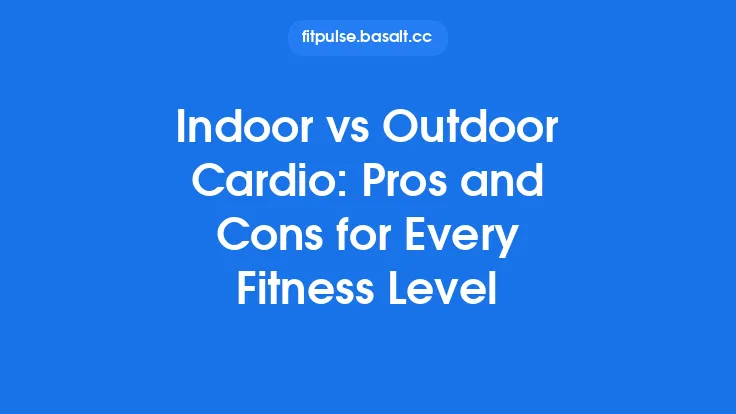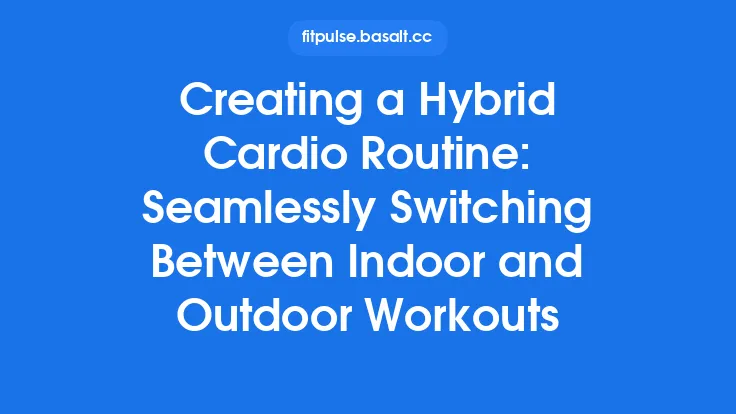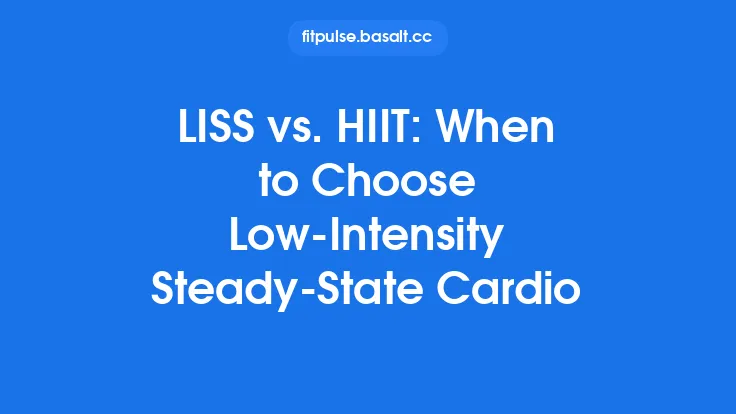Cardiovascular exercise is widely recognized for its physical benefits, yet its influence on mental health is equally profound. Whether you lace up your shoes for a run through a park or hop onto a treadmill in a climate‑controlled gym, the act of moving your heart and lungs triggers a cascade of psychological effects. Understanding how the environment—outdoor versus indoor—shapes these mental health outcomes can help you tailor your cardio routine to support mood, cognition, stress resilience, and overall emotional well‑being.
Neurochemical Responses to Cardio Exercise
Both outdoor and indoor cardio stimulate the release of key neurotransmitters and hormones that underlie mood regulation:
| Neurochemical | Primary Effect on Mental Health | How Cardio Influences It |
|---|---|---|
| Endorphins | Natural analgesics; produce a “runner’s high.” | Aerobic intensity above 60 % VO₂max triggers endorphin release, regardless of setting. |
| Serotonin | Stabilizes mood, reduces depressive symptoms. | Sustained cardio increases tryptophan availability, boosting central serotonin synthesis. |
| Dopamine | Enhances motivation, reward perception, and focus. | Repetitive rhythmic movement reinforces dopaminergic pathways linked to habit formation. |
| Norepinephrine | Improves attention and arousal. | Moderate‑to‑high intensity cardio elevates plasma norepinephrine, sharpening mental alertness. |
| Cortisol | Stress hormone; chronic elevation is detrimental. | Acute cardio temporarily raises cortisol, but regular sessions lower baseline levels, improving stress resilience. |
| Brain‑Derived Neurotrophic Factor (BDNF) | Supports neurogenesis and cognitive flexibility. | Aerobic exercise upregulates BDNF expression, especially when performed at moderate intensity for ≥30 minutes. |
While the biochemical cascade is fundamentally similar across environments, the magnitude and downstream psychological impact can differ due to ancillary sensory and contextual cues, as explored in the following sections.
The Role of Natural Environments in Mood Regulation
Exposure to natural settings—trees, water, open sky—has been shown to produce additive mood benefits beyond the exercise itself. This phenomenon, often termed “green exercise,” leverages several mechanisms:
- Attention Restoration Theory (ART): Natural scenes provide soft fascination, allowing the directed attention system to recover from mental fatigue. When cardio is performed outdoors, the rhythmic movement combined with effortless visual engagement promotes quicker restoration of attentional capacity.
- Biophilia Hypothesis: Humans possess an innate affinity for living systems. Engaging with nature during cardio can evoke feelings of connectedness and purpose, which are protective against depressive rumination.
- Psychophysiological Synchrony: The variability of terrain (e.g., slight inclines, uneven paths) introduces subtle proprioceptive challenges that synchronize motor output with environmental feedback, fostering a sense of flow and intrinsic reward.
Collectively, these factors contribute to measurable improvements in affective state. Studies using the Profile of Mood States (POMS) have reported larger reductions in tension‑anxiety and fatigue after outdoor runs compared with treadmill sessions of equivalent intensity and duration.
Sunlight Exposure and Circadian Rhythm Alignment
Sunlight is a potent zeitgeber—an external cue that synchronizes the body’s internal clock. Outdoor cardio performed during daylight hours offers two distinct mental health advantages:
- Vitamin D Synthesis: Ultraviolet B (UVB) radiation catalyzes the conversion of 7‑dehydrocholesterol to vitamin D₃, a nutrient implicated in serotonin regulation and mood stabilization. Even modest sun exposure (10–15 minutes) can raise serum vitamin D levels, which correlates with lower rates of seasonal affective disorder (SAD).
- Melatonin Regulation: Bright light exposure suppresses melatonin production during the day, reinforcing a robust day‑night hormonal rhythm. A well‑entrained circadian system improves sleep quality, which in turn enhances emotional regulation, memory consolidation, and stress coping.
Indoor cardio, unless supplemented with bright artificial lighting or scheduled strategically, lacks these photic inputs. Consequently, individuals who primarily exercise indoors may need to incorporate additional light therapy or schedule outdoor sessions to reap circadian benefits.
Sensory Stimulation and Cognitive Engagement
The sensory landscape of an outdoor cardio session is inherently richer than that of a controlled indoor environment. This heightened stimulation can influence cognitive processes in several ways:
- Multimodal Integration: Visual (landscape), auditory (birds, wind), olfactory (fresh air, foliage), and vestibular (uneven ground) inputs converge, demanding continuous integration. This engagement promotes neuroplasticity in the parietal and temporal cortices, supporting spatial awareness and memory.
- Dynamic Decision‑Making: Outdoor routes often require spontaneous adjustments—choosing a path, navigating obstacles, or responding to traffic. These micro‑decisions activate executive functions, reinforcing prefrontal cortex activity and improving problem‑solving skills.
- Reduced Sensory Deprivation: Indoor cardio spaces can be monotonous, especially when the visual field is limited to a wall or a screen. Prolonged sensory deprivation may lead to mind‑wandering or decreased motivation, potentially dampening the mood‑lifting effects of exercise.
While indoor cardio can incorporate virtual reality or varied music playlists to augment sensory input, the authenticity and unpredictability of natural stimuli remain unique to outdoor settings.
Social and Community Aspects of Outdoor Cardio
Even when performed alone, outdoor cardio often occurs within a broader social context that subtly influences mental health:
- Incidental Social Interaction: Passing runners, cyclists, or park-goers provide brief, low‑stakes social contact. These micro‑interactions can boost feelings of belonging and reduce perceived loneliness.
- Community Identity: Regular participation in local trails, parks, or organized outdoor groups fosters a sense of place and community attachment. This affiliation has been linked to higher self‑esteem and lower depressive symptoms.
- Observational Modeling: Seeing others engage in physical activity can serve as a vicarious reinforcement, encouraging personal adherence and reinforcing positive health norms.
Indoor cardio, especially in solitary home settings, may lack these ambient social cues. However, group fitness classes or virtual communities can partially replicate the communal benefits, though the spontaneous, unstructured nature of outdoor social exposure is distinct.
Psychological Flexibility and Mindfulness in Indoor Settings
Indoor cardio environments, while less variable, can be deliberately structured to cultivate mindfulness and psychological flexibility:
- Controlled Pace for Meditative Focus: The predictable rhythm of a treadmill or stationary bike allows practitioners to synchronize breath with stride, fostering a meditative state that reduces rumination.
- Environmental Cue Management: The ability to eliminate external distractions (traffic noise, weather) creates a mental “blank canvas,” enabling focused introspection and emotional processing.
- Goal‑Oriented Visualization: Indoor sessions often incorporate performance metrics (speed, distance, heart rate). Using these data points as anchors for present‑moment awareness can enhance self‑regulation and reduce anxiety about external variables.
Thus, while indoor cardio may lack natural stimuli, it offers a platform for intentional mental training that can be equally beneficial when approached with a mindfulness framework.
Comparative Impact on Stress and Anxiety Levels
Empirical research comparing stress biomarkers and self‑reported anxiety after outdoor versus indoor cardio reveals nuanced differences:
- Cortisol Recovery: Both settings lower basal cortisol after regular training, but outdoor cardio tends to produce a faster acute cortisol decline post‑exercise, likely due to the combined effect of physical exertion and natural environment exposure.
- Heart Rate Variability (HRV): Higher HRV—a marker of autonomic flexibility and stress resilience—is observed after outdoor sessions, reflecting greater parasympathetic reactivation during recovery.
- Subjective Anxiety: Participants consistently report lower state anxiety scores after outdoor runs, attributing the reduction to the calming influence of nature and the sense of openness.
- Perceived Stress Scale (PSS) Trends: Longitudinal studies show a modest but statistically significant greater reduction in PSS scores for individuals who incorporate at least two outdoor cardio sessions per week, compared with those who train exclusively indoors.
These findings suggest that while both environments confer stress‑relieving benefits, the additive natural component of outdoor cardio amplifies the effect.
Long‑Term Mental Health Outcomes
When cardio is sustained over months to years, the cumulative mental health advantages become more pronounced:
- Depression Prevention: Meta‑analyses indicate that regular aerobic activity reduces the incidence of major depressive disorder by up to 30 %. Outdoor cardio participants exhibit a slightly higher protective effect, possibly due to synergistic mood‑enhancing mechanisms described earlier.
- Cognitive Aging: Outdoor cardio has been linked to slower age‑related decline in executive function and memory, mediated by higher BDNF levels and enriched environmental stimulation.
- Resilience to Trauma: Veterans and individuals with post‑traumatic stress disorder (PTSD) report greater symptom alleviation when cardio includes nature exposure, highlighting the therapeutic potential of green exercise.
- Sleep Quality: The combination of physical fatigue and daylight exposure from outdoor cardio improves sleep onset latency and sleep efficiency more robustly than indoor cardio alone.
These long‑term outcomes underscore the importance of considering environmental context when designing cardio programs aimed at mental health optimization.
Practical Recommendations for Maximizing Mental Health Benefits
- Blend Both Settings: Aim for at least two outdoor cardio sessions per week (e.g., a 30‑minute jog in the morning) complemented by indoor sessions when weather or schedule constraints arise.
- Prioritize Morning Light: Schedule outdoor cardio within the first two hours after sunrise to harness circadian benefits and vitamin D synthesis.
- Incorporate Mindful Breathing: Whether indoors or outdoors, synchronize inhalation with foot strike and exhalation with the opposite foot to deepen parasympathetic activation.
- Utilize Natural Landmarks: Choose routes with varied scenery—trees, water, open fields—to stimulate attention restoration and enhance mood.
- Leverage Social Micro‑Interactions: Greet fellow park users, join community runs, or simply acknowledge the presence of others to boost social connectedness.
- Track Mood Metrics: Keep a simple journal noting affective state before and after each session. Over time, patterns will reveal which environment yields the greatest personal benefit.
- Adjust Intensity for Flow: Moderate intensity (≈65 % of maximal heart rate) often produces the optimal balance between physiological challenge and psychological enjoyment, facilitating a flow state.
- Create an Indoor Sanctuary: If indoor cardio is predominant, enhance the space with natural elements—plants, daylight‑mimicking lamps, calming artwork—to partially replicate outdoor sensory input.
Closing Thoughts
Cardiovascular exercise is a powerful lever for mental health, and the environment in which it is performed can modulate its psychological impact. Outdoor cardio leverages natural light, green surroundings, and spontaneous social cues to amplify mood elevation, stress reduction, and cognitive resilience. Indoor cardio, while lacking these extrinsic stimuli, offers a controlled arena for focused mindfulness, consistent training, and personalized pacing. By understanding the distinct mental health pathways activated in each setting, you can craft a cardio regimen that not only strengthens the heart but also nurtures the mind—creating a sustainable foundation for lifelong emotional well‑being.





